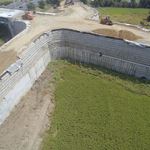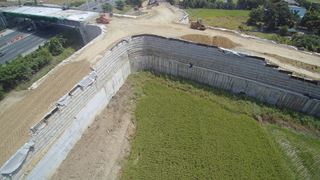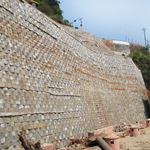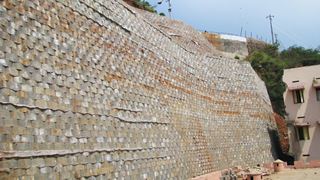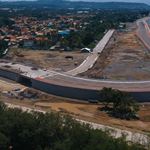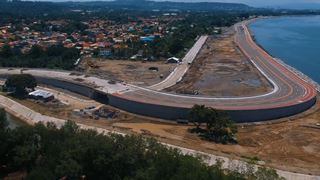Case story
Reinforced Steep Slope using Polyfelt® PEC Geocomposite
Malaysia, Sarawak, Kapit
Project Data
| Project | Reinforced Steep Slope |
| Location | Kapit, Sarawak, Malaysia |
| Products used | Polyfelt® PEC |
Project Description
This project required an embankment to be constructed with side slopes of over 63 degrees. The steep slope has to be stable, easy to construct and the facing should require little or no maintenance in a high rainfall tropical forest area in Sarawak, Malaysia. To support the road construction, the slope needs to be constructed to a height of 12m at the highest point. Due to the remote location of the site, a reinforced soil system that can utilise on-site available earth would be cost effective and ideal for logistics. Residual soil can be easily excavated on-site and used as backfill material. However, the residual soil has high fines content (65% of silt and clay) and is susceptible to moisture softening effects. With these considerations, Polyfelt® PEC reinforcement composite was selected for its high tensile modulus and good in-plane drainage properties.
The facing system involves a stone and bent wire mesh facing system. This system is easy to construct, requires minimal transportation of material as only wire mesh is required, and stones which are readily available as part of the road construction project. The wire mesh is hot-dipped galvanised for long term performance and can be bent on-site to the required facing angle easily.
Installation
The construction of the reinforced soil structure is relatively simple. The unsuitable soil is excavated from the foundation and re-compacted with 0.5 to 1.0m thick of granular fills on top of a layer of geotextile separator to form a layer of levelling pad. The steel mesh facing panels were then placed and strengthened with steel ties. A layer of Polyfelt® PEC composite reinforcement was then placed and fastened to the facing panels with zip-ties. Stones were placed behind the facing panels and the geosynthetic reinforcement was pulled taut and pegged at the end. A small trench was excavated under the middle of the composite reinforcement to provide pre-tensioning.
Residual soil backfill was placed in lifts of 150 mm and compacted with plate compactors up to approximately 1.0 m from the facing of the wall, after which a lift of 300 mm was placed and compacted with a regular roller. The process was repeated for the subsequent layers until completion.
Horizontal and vertical drainage layers consisting of 300 mm thick aggregates were placed at the bottom and back of the reinforced fill at each berm to remove water seepage from the back and top of the reinforced soil structure.
Conclusion
The use of Polyfelt® PEC composite reinforcement allowed the use of on-site high fines content residual soil as backfill. The use of stone and bent wire mesh facing system provided a low maintenance and aesthetically pleasing facing to the reinforced slope system, which was the most economical and practical solution given the remoteness of the site with very high rainfall.



